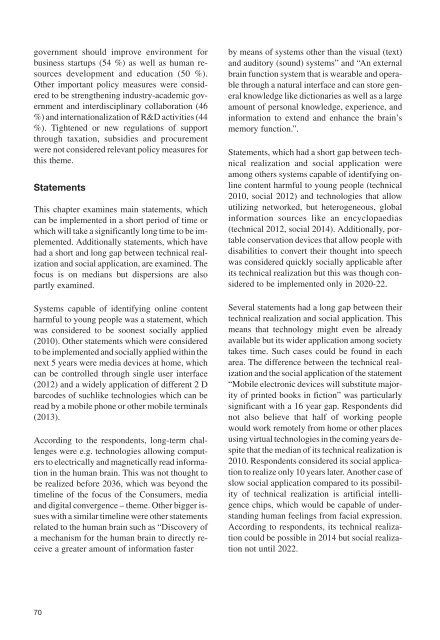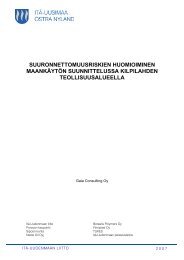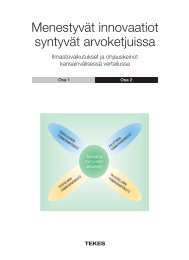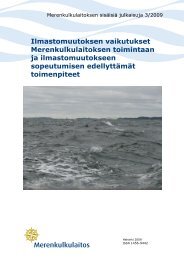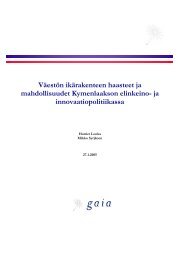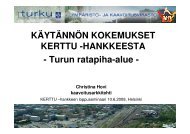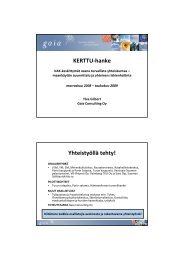227/08 Social challanges s the basis for foresight - Gaia
227/08 Social challanges s the basis for foresight - Gaia
227/08 Social challanges s the basis for foresight - Gaia
Create successful ePaper yourself
Turn your PDF publications into a flip-book with our unique Google optimized e-Paper software.
government should improve environment <strong>for</strong><br />
business startups (54 %) as well as human resources<br />
development and education (50 %).<br />
O<strong>the</strong>r important policy measures were considered<br />
to be streng<strong>the</strong>ning industry-academic government<br />
and interdisciplinary collaboration (46<br />
%) and internationalization of R&D activities (44<br />
%). Tightened or new regulations of support<br />
through taxation, subsidies and procurement<br />
were not considered relevant policy measures <strong>for</strong><br />
this <strong>the</strong>me.<br />
Statements<br />
This chapter examines main statements, which<br />
can be implemented in a short period of time or<br />
which will take a significantly long time to be implemented.<br />
Additionally statements, which have<br />
had a short and long gap between technical realization<br />
and social application, are examined. The<br />
focus is on medians but dispersions are also<br />
partly examined.<br />
Systems capable of identifying online content<br />
harmful to young people was a statement, which<br />
was considered to be soonest socially applied<br />
(2010). O<strong>the</strong>r statements which were considered<br />
to be implemented and socially applied within <strong>the</strong><br />
next 5 years were media devices at home, which<br />
can be controlled through single user interface<br />
(2012) and a widely application of different 2 D<br />
barcodes of suchlike technologies which can be<br />
read by a mobile phone or o<strong>the</strong>r mobile terminals<br />
(2013).<br />
According to <strong>the</strong> respondents, long-term challenges<br />
were e.g. technologies allowing computers<br />
to electrically and magnetically read in<strong>for</strong>mation<br />
in <strong>the</strong> human brain. This was not thought to<br />
be realized be<strong>for</strong>e 2036, which was beyond <strong>the</strong><br />
timeline of <strong>the</strong> focus of <strong>the</strong> Consumers, media<br />
and digital convergence – <strong>the</strong>me. O<strong>the</strong>r bigger issues<br />
with a similar timeline were o<strong>the</strong>r statements<br />
related to <strong>the</strong> human brain such as “Discovery of<br />
a mechanism <strong>for</strong> <strong>the</strong> human brain to directly receive<br />
a greater amount of in<strong>for</strong>mation faster<br />
70<br />
by means of systems o<strong>the</strong>r than <strong>the</strong> visual (text)<br />
and auditory (sound) systems” and “An external<br />
brain function system that is wearable and operable<br />
through a natural interface and can store general<br />
knowledge like dictionaries as well as a large<br />
amount of personal knowledge, experience, and<br />
in<strong>for</strong>mation to extend and enhance <strong>the</strong> brain’s<br />
memory function.”.<br />
Statements, which had a short gap between technical<br />
realization and social application were<br />
among o<strong>the</strong>rs systems capable of identifying online<br />
content harmful to young people (technical<br />
2010, social 2012) and technologies that allow<br />
utilizing networked, but heterogeneous, global<br />
in<strong>for</strong>mation sources like an encyclopaedias<br />
(technical 2012, social 2014). Additionally, portable<br />
conservation devices that allow people with<br />
disabilities to convert <strong>the</strong>ir thought into speech<br />
was considered quickly socially applicable after<br />
its technical realization but this was though considered<br />
to be implemented only in 2020-22.<br />
Several statements had a long gap between <strong>the</strong>ir<br />
technical realization and social application. This<br />
means that technology might even be already<br />
available but its wider application among society<br />
takes time. Such cases could be found in each<br />
area. The difference between <strong>the</strong> technical realization<br />
and <strong>the</strong> social application of <strong>the</strong> statement<br />
“Mobile electronic devices will substitute majority<br />
of printed books in fiction” was particularly<br />
significant with a 16 year gap. Respondents did<br />
not also believe that half of working people<br />
would work remotely from home or o<strong>the</strong>r places<br />
using virtual technologies in <strong>the</strong> coming years despite<br />
that <strong>the</strong> median of its technical realization is<br />
2010. Respondents considered its social application<br />
to realize only 10 years later. Ano<strong>the</strong>r case of<br />
slow social application compared to its possibility<br />
of technical realization is artificial intelligence<br />
chips, which would be capable of understanding<br />
human feelings from facial expression.<br />
According to respondents, its technical realization<br />
could be possible in 2014 but social realization<br />
not until 2022.


